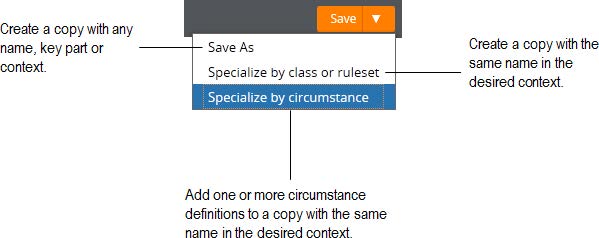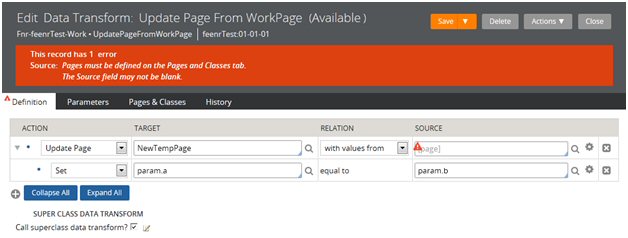Create, Save As, and Specialization forms
Valid from Pega Version 7.1.4
The familiar “New” and “Save As” forms have been streamlined to make record creation faster and more intuitive. You can easily target a specific layer in your application stack, interactively define the record’s configuration and select only those circumstance definitions that make sense for your use case.
While the underlying behavior for creating a record is not new for this release, the redesigned UI of these forms and new defaulting strategy for fields is worth noting:

To launch these forms, use one of the new options found in the action area of the form header:

Note that not all record types support the ability to specialize by circumstance.
For more guidance on how to use the Create, Save As and Specialization forms, please refer to: Intuitive record creation and specialization
Redirect users to logout screen
Valid from Pega Version 7.1.4
New applications built in Version 7.1 will automatically redirect users to the PRPC login page upon logout.
A new template, Web-Session-Return-Template, has been added, to allow developers to customize their applications to redirect users to a logout page, if they wish. This template can be copied to a ruleset visible to unauthenticated requestors (via node configuration) and used to override Web-Session-Return.
Source field not displaying in data transform
Valid from Pega Version 7.1.4
On the Data Transform rule form when using the Update Page action, if the Relation value is updated to “with values from”, the Source field will not be displayed.
(Note that for existing data transforms where the Source field has already been completed, this situation should not occur.)
Workaround
- Below is a data transform that has been configured to use Update Page.

- If a user were to choose an alternate source by updating the ‘with values from’ Relation value, they would not be prompted to provide a page name in the Source field.

- At this point, to be able to enter the Source page value, the user has to save the rule, which results in an error because the source page value is blank. This causes the field to appear.

- Once the field has appeared, the Source page value can be provided, and the form can be saved successfully.

Core Engine
Valid from Pega Version 7.1.4
This release contains fixes related to clipboard and declarative features, including data pages and autopopulate.
- A rule may be changed using Private Checkout, and then checked into a higher RuleSet Version for that RuleSet.
- Agents may now use a 24-hour time period for scheduling, as well as a 12-hour time period (which required the selection of AM or PM).
- Caching and performance have been enhanced.
- Declare expressions will work with embedded page lists when creating forms.
- Mandatory parameters on a data page can handle blank values.
- Properties may be auto-populated using a reference property which is created with a Property-Ref method in an activity.
- System will use "private edit" rules in developer's personal RuleSet when that rule overrides the "standard" rule available to all.
- The Page-Remove method will now remove Data Pages at the Thread level and the Requestor Level.
- When copying a page using the "Set" action on a data transform, the Declare Indexes defined on that data will be updated.
- When creating a data page, the Reload Once per Interaction checkbox can be checked to set the refresh strategy.
Designer Studio
Valid from Pega Version 7.1.4
Many refinements to the Designer Studio were made around performance and user experience. Based on feedback, we have made a number of bug fixes and strategic improvements that improve the overall user experience.
- The Developer Portal connects to the PDN's RSS feed without needing a DigiCert certificate for validation. The RSS feed is just headlines; to open and read any of the articles, users will still have to log into the PDN.
- Expression Builder has been enhanced to work with IE8.
- New applications built in Version 7.1 will automatically redirect users to the PRPC login page upon logout. A new template has been added, to allow developers to customize their applications to redirect users to a logout page, if they wish.
- Performance improvements were made when saving and validating rules.
- Performance of the Guardrails Dashboard has been improved.
- The display of circumstanced rules in Application Explorer has been enhanced.
Reporting & Data
Valid from Pega Version 7.1.4
This release fixed many existing unlocalizable elements in 7.1 reporting interfaces (The Report Viewer, Report Editor, Chart Editor, and the Report Browser) and now they are fully localizable. Changes were made to make Listview, summaryview, and report viewer display possible WCAG 2.0 level A and AA support.
- Parameters may now be used in a sub-report join condition.
- Report Definition localization has been enhanced.
- Standalone ListViews with embedded SmartInfo have been improved to resize appropriately when the SmartInfo section is expanded.
- The data section of a report will now display in all of the available space when a fixed header option is selected.
- When localizing a listview with filters, tool tips are translated.
Ability to include all properties in search results
Valid from Pega Version 7.4
You can now include all properties in a class in search results so that they can be used in report filtering. When the Enable search results for all properties option is selected on the Custom Search Properties rule form, all top level and embedded page scalar properties for the class are indexed and returned in search results, and all embedded page list, page group, value list, and value group properties for the class are indexed but not returned in search results. Selecting this option might affect performance.
In addition, by default, properties defined in the Data-Tag-RelevantRecord instance for a class are indexed and returned in search results and do not need to be explicitly configured.
You must reindex search after selecting or clearing Enable search results for all properties and after changing the properties that are defined in the Data-Tag-RelevantRecord instance.
For more information, see Specifying custom search properties.
Support for additional health metrics on the Application Quality landing page
Valid from Pega Version 7.4
On the Application Quality landing page, you can monitor the health of your current application to identify areas that need improvement before deployment. The landing page provides application metrics such as the number of executable rules, the guardrail score, the number of guardrail warnings, the test coverage percentage, and the pass rate of PegaUnit tests. From this landing page, you can also view data for the entire application, for each of its cases, and for rules that are not part of any case type.
For more information, see Application Quality landing page.
View the configuration settings for Pega Platform nodes in Designer Studio
Valid from Pega Version 7.4
On the new Configuration Settings landing page, you can view a list of the configuration settings for a specific node, current or remote, or for an entire cluster. From this landing page you can diagnose settings issues, determine whether settings are loaded correctly, and review the settings' purposes. You can also download the prconfig.xml file for any node in a cluster to modify the settings. The ability to view settings for all nodes in the Cluster from a single landing page makes diagnosing configuration issues across the cluster simpler and easier than logging on to each node individually to view its system settings. For example, if a started agent does not run, you can check if agents are enabled on your system; or if some of your caches are too big, you can check the setting for the cache size. You can also determine if settings are loaded correctly, and identify discrepancies in the settings across the nodes.
For more information, see Viewing the current configuration settings of a node or the whole cluster, Downloading and viewing the prconfig.xml file for a specific node, REST APIs for viewing the configuration settings for Pega Platform.
Support for templated auto responses during email triaging of interaction cases
Valid from Pega Version 7.4
When you triage an interaction case by email, you can now select a predefined email response to provide feedback to a customer more quickly. The category that is associated with this email determines the type of responses that you can select. You can create an email response template or use an existing template.
For more information, see Defining suggested replies for the Email channel.

